法语现在分词的用法
法语现在分词和动名词
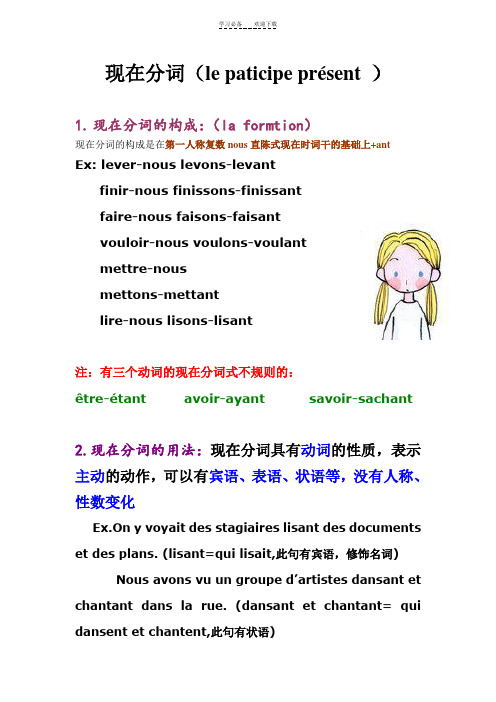
现在分词(le paticipe présent )1.现在分词的构成:(la formtion)现在分词的构成是在第一人称复数nous直陈式现在时词干的基础上+antEx: lever-nous levons-levantfinir-nous finissons-finissantfaire-nous faisons-faisantvouloir-nous voulons-voulantmettre-nousmettons-mettantlire-nous lisons-lisant注:有三个动词的现在分词式不规则的:être-étant avoir-ayant savoir-sachant2.现在分词的用法:现在分词具有动词的性质,表示主动的动作,可以有宾语、表语、状语等,没有人称、性数变化Ex.On y voyait des stagiaires lisant des documents et des plans. (lisant=qui lisait,此句有宾语,修饰名词) Nous avons vu un groupe d’artistes dansant et chantant dans la rue. (dansant et chantant= qui dansent et chantent,此句有状语)◆关系从句:现在分词用作定语,紧接在被修饰成分后面,不用逗号分开,相当于qui引导的限定性关系从句。
ex.Les touristes étrangers cherchent àtrouver un guide connaissant à la fois lefrançais et l’anglais. (connaissant=qui connaisse,相当于形容词性从句)◆状语从句:现在分词和被修饰成分分开(一般是主句主语,)用作同位语,相当于副词性从句,表示时间、原因、让步或条件等。
法语-语法结构表
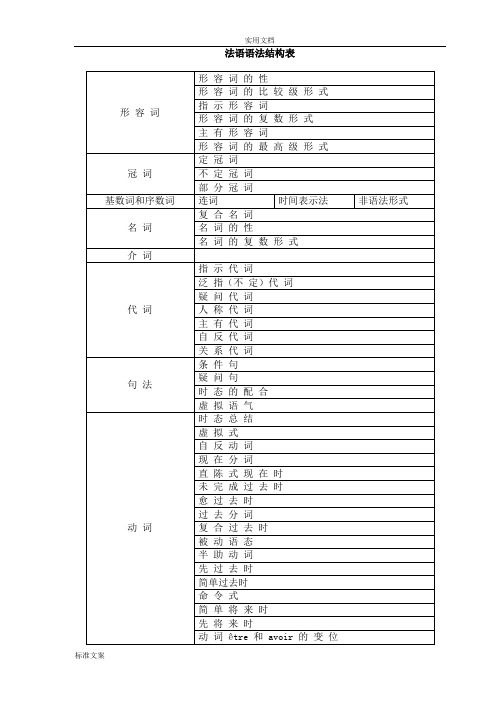
法语语法结构表一形容词1. 形容词的性法语形容词的性和数要和他们所修饰的名词相一致。
因此,法语形容词相应的有四种形式:阳性单数、阴性单数、阳性复数和阴性复数。
1. 形容词的阴性形式一般在阳性形式后面加字母-e即可。
阳性形容词:Un petit garçon.一个小男孩。
阴性形容词:Une petite fille.一个小女孩。
以-e结尾的阳性形容词变成阴性时,形式不发生改变:Un travail facile.一份容易的工作。
Une question facile.一个简单的问题。
以-el、-eil和双-l结尾的阳性形容词变成阴性形式时,在后面加-e:Un problème éventuel.一个可能(发生)的问题。
Une solution éventuelle.一个可行的解决方法。
以-en、-on结尾的阳性形容词变成阴性形式时,双写-n后加-e:Un ancien élève.一个老(过去的)学生。
Une ancienne élève.一个老(过去的女)学生。
以-et结尾的阳性形容词变成阴性形式时,双写-t,然后加-e:Un homme muet.一个哑巴。
Une femme muette.一个女哑巴。
特殊情况:以下形容词变成阴性形式时,把-et变成-ète:un plan secret一个秘密计划une pensée secrète一个秘密的想法以-x结尾的阳性形容词通常变-x为-se构成阴性形式:Un homme généreux.一个慷慨的男人。
Une personne généreuse.一个慷慨的人。
以-s结尾的阳性形容词变阴性形式时,根据一般规则在后面加-e。
特殊情况:以下形容词双写-s后加-e:以-er结尾的阳性形容词变成阴性形式时,为-ère:Un premier pas.第一步。
现在分词和副动词的用法及区别

主要区别:副动词⽤来修饰动词,现在分词⽤来修饰名词或代词;现在分词多⽤语笔语,⼝语中很少使⽤,⽽副动词可以⽤于⼝语。
现在分词(le participe présent)的构成:去掉直陈式第⼀⼈称复数的词尾-ons,另加-ant.例 faire : nous faisons ;faisant 特殊情况:avoir-ayant ; etre-etant ; savoir-sachant ⽤法: 1)⽤作定语,紧接在被修饰词之后,相当于qui引导的从句 L'étranger cherche à trouver quelqun connaissant(=qui conaisse) à la fois francasi et l'anglais. 2)表原因、时间 Voyant(=Comme elle voit) que tout le monde est dejà assis,elle va vite à sa place. Ayant(=Comme il a) mal à la tete,il décide de rester au lit. 副动词(le gé rondif)构成:在现在分词前加en就构成副动词 faire : en faisant ⽤法: 1)时间状语,表⽰动作的同时性 N'oubliez pas de fermer la port en sortant.出去时别忘了关门。
Ne lis pas en mangeant. 不要以便吃饭以⼀边看书。
2)⽅式、⽅法状语 Elle arriva en courant. 她跑来了。
3)条件状语 En se levant plus tot le matin, il n'arrivera pas en retard.如果早上起的早点,他就不会迟到了。
法语现在分词的用法
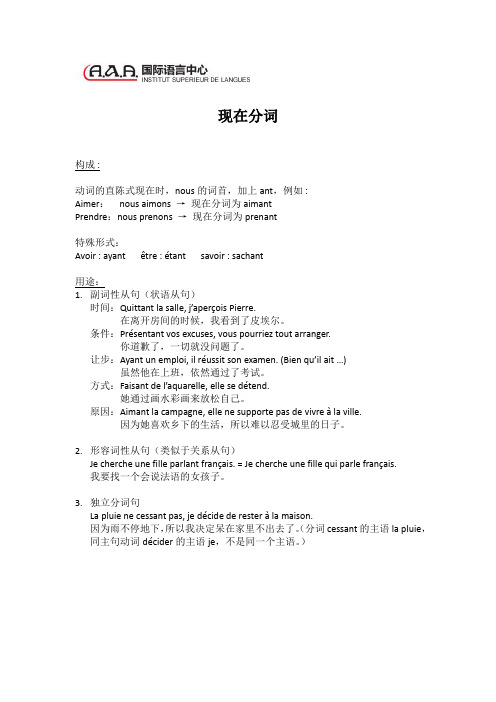
现在分词构成 :动词的直陈式现在时,nous的词首,加上ant,例如 :Aimer:nous aimons →现在分词为aimantPrendre:nous prenons →现在分词为prenant特殊形式:Avoir : ayant être : étant savoir : sachant用途:1.副词性从句(状语从句)时间:Quittant la salle, j’aperçois Pierre.在离开房间的时候,我看到了皮埃尔。
条件:Présentant vos excuses, vous pourriez tout arranger.你道歉了,一切就没问题了。
让步:Ayant un emploi, il réussit son examen. (Bien qu’il ait …)虽然他在上班,依然通过了考试。
方式:Faisant de l’aquarelle, elle se détend.她通过画水彩画来放松自己。
原因:Aimant la campagne, elle ne supporte pas de vivre à la ville.因为她喜欢乡下的生活,所以难以忍受城里的日子。
2.形容词性从句(类似于关系从句)Je cherche une fille parlant français. = Je cherche une fille qui parle français.我要找一个会说法语的女孩子。
3.独立分词句La pluie ne cessant pas, je décide de rester à la maison.因为雨不停地下,所以我决定呆在家里不出去了。
(分词cessant的主语la pluie,同主句动词décider的主语je,不是同一个主语。
新大学法语语法总结
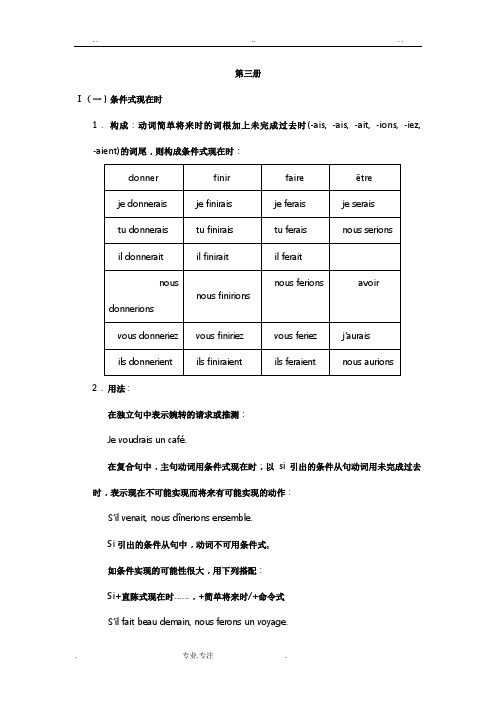
第三册Ⅰ(一)条件式现在时1.构成:动词简单将来时的词根加上未完成过去时(-ais, -ais, -ait, -ions, -iez, -aient)的词尾,则构成条件式现在时:2.用法 :在独立句中表示婉转的请求或推测:Je voudrais un café.在复合句中,主句动词用条件式现在时;以si引出的条件从句动词用未完成过去时,表示现在不可能实现而将来有可能实现的动作:S’il venait, nous dînerions ensemble.Si引出的条件从句中,动词不可用条件式。
如条件实现的可能性很大,用下列搭配:Si+直陈式现在时……,+简单将来时/+命令式S’il fait beau demain, nous ferons un voyage.Ⅰ(二)条件式过去时1. 构成:用助动词avoir或être的条件式现在时加动词的过去分词。
2. 用法:条件式过去时表示在过去可能实现而并未实现的动作(1). 条件状语从句用愈过去时,主句用条件式过去时:S’il n’avait pas plu hier, nous serions allés en ville.(2). 条件从句用表示条件的词或短语来代替:Il m’attendait, sinon, il serait parti plus to^t.(3). 条件式过去时用在独立句中,表示惋惜、怨恨、愿望等感情:Vous auriez du^ me le dire!您要是早告诉我就好了!(4). 在新闻报道中,表示未经证实的事:Un accident aurait eu lieu sur la place.Ⅱ虚拟式现在时1.构成:去掉动词直陈式现在时复数第三人称词尾-ent,再依人称顺序加下列词尾,即构成虚拟式:-e, -es, -e, -ions,-iez, -ent2. 用法(一):用在某些副词性从句中(1). 用在下列表示目的的连词短语引出的从句中:pour que为了,afin que为了,de peur que以免,de crainte que免得Pour qu’ils puissent bien connaître la vie en Chine, on a organisé beaucoup de voyages.(2). 用在下列表示时间的连词短语引出的从句中:avant que在……之前,en attendant que直到,jusqu’à ce que一直到Partez avant qu’il ne pleuve.(3). 用在下列表示原因、条件、假设的连词短语引出的从句中:à moins que除非,à condition que只要Nous ne pouvons pas finir ces travaux à temps, à moins que vous veniez nous aider.(4). 用在下列表示让步的短语引出的从句中:bien que虽然,quoique虽然,qui que不论是谁,quoi que不论什么,oùque无论哪,quelque...que无论如何,quel(quelle,quels, quelles)que不论什么样的Bien que mon grand-père soir malade, il ne veut pas se reposer.Quelle que soir la difficulté, nous la surmonterons.3. 用法(二):用在名词性从句中(1). 主句中有下列表示命令、请求或愿望的动词或动词短语aimer, demander, défendre禁止, désirer, exiger强求, interdire禁止,ordonner, permettre, refuser, souhaiter希望, vouloir, prendre garde当心, aimer mieux.J’aime que tu sois guéri rapidement.我希望你早日康复。
法语现在分词和动名词【范本模板】
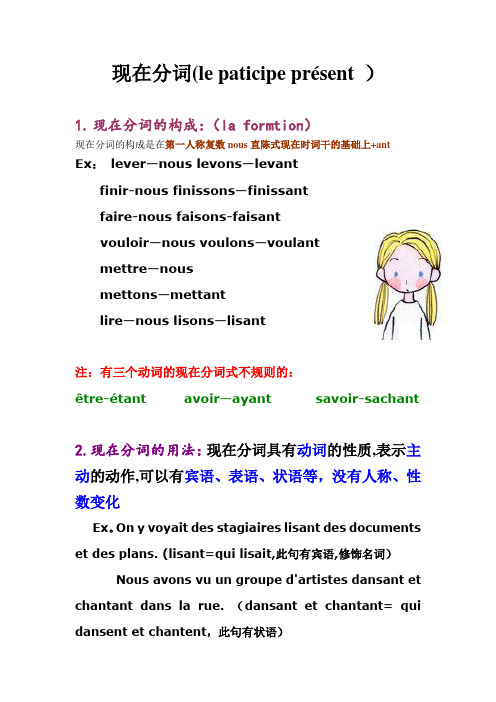
现在分词(le paticipe présent )1.现在分词的构成:(la formtion)现在分词的构成是在第一人称复数nous直陈式现在时词干的基础上+ant Ex:lever—nous levons—levantfinir-nous finissons—finissantfaire-nous faisons-faisantvouloir—nous voulons—voulantmettre—nousmettons—mettantlire—nous lisons—lisant注:有三个动词的现在分词式不规则的:être-étant avoir—ayant savoir-sachant2.现在分词的用法:现在分词具有动词的性质,表示主动的动作,可以有宾语、表语、状语等,没有人称、性数变化Ex。
On y voyait des stagiaires lisant des documents et des plans. (lisant=qui lisait,此句有宾语,修饰名词)Nous avons vu un groupe d'artistes dansant et chantant dans la rue. (dansant et chantant= qui dansent et chantent,此句有状语)◆关系从句:现在分词用作定语,紧接在被修饰成分后面,不用逗号分开,相当于qui引导的限定性关系从句。
ex。
Les touristes étrangers cherchent àtrouver un guide connaissant à la fois lefrançais et l’anglais。
(connaissant=qui connaisse,相当于形容词性从句)◆状语从句:现在分词和被修饰成分分开(一般是主句主语,)用作同位语,相当于副词性从句,表示时间、原因、让步或条件等。
法语中现在分词与副动词的用法
《法语中现在分词与副动词的用法》主要区别:副动词用来修饰动词,现在分词用来修饰名词或代词;现在分词多用语笔语,口语中很少使用,而副动词可以用于口语。
现在分词(le participe présent)构成:去掉直陈式第一人称复数的词尾-ons,另加-ant faire : nous faisons ; faisant特殊情况:avoir-ayant ; etre-etant ; savoir-sachant用法:1)用作定语,紧接在被修饰词之后,相当于qui引导的从句L'étranger cherche à trouver quelqun connaissant(=qui conaisse) à la fois le français etl'anglais.2)表原因、时间Voyant(=Comme elle voit) que tout le monde est dejà assis,elle va vite à sa place.Ayant(=Comme il a) mal à la tete,il décide de rester au lit.副动词(le gé rondif)构成:在现在分词前加en就构成副动词faire : en faisant用法:1)时间状语,表示动作的同时性N'oubliez pas de fermer la port en sortant.出去时别忘了关门。
Ne lis pas en mangeant. 不要以便吃饭以一边看书2)方式、方法状语Elle arriva en courant. 她跑来了3)条件状语En se levant plus tot le matin, il n'arrivera pas en retard.如果早上起的早点,他就不会迟到了。
法语语法现在分词
现在分词现在分词的构成:去掉直陈式现在时第一人称复数词尾的-ons,另加-ant 即成,avoir,être;sqvoir 等动词除外。
例如:avoir,être;sqvoir 的现在分词不规则,如下:用法:现在分词在法语中有多种用法:1.现在分词转化的形容词,要和它们所修饰的名词的性、数相一致,如:un poème émouvant一首动听的诗歌une conversation stimulante一次刺激的交谈des jardins florissants鲜花盛开的花园des nouvelles surprenantes令人吃惊的新闻1.动词用来表示行为,无性、数变化,如:en courant vers le marché跑着去市场en faisant ceci et cela在做这做那Ils le reconduisirent en chantant.他们唱着歌把他送回去了。
Un homme tenant une lampe à la main s'avança vers moi.一个拿着手电筒的男人朝我走过来。
注释:现在分词可以跟在介词“en”后,作副词成分,表示原因、方式、同时性等。
Elle se sentait mal en voyageant par avion.她坐飞机旅行时感到不舒服。
Nous avons fait le tour de Londres en assistantà la conférence.我们参加讨论会时转了转伦敦。
En dégustant le vin, ils ont été surpris.品尝着这酒,他们很惊讶。
注释:在以 "en" 加现在分词形成的句子中,现在分词所表达的动作总是指该句的主语。
法语分词式
条件状语从句: Prenant un taxi, nous pourrions arriver àtemps. (=Si nous prenions un taxi) 我们如果乘坐出租车,就能够准时到达。
阳性单数:un film parlant 有声电影 阴性单数:la chaleur suffocante 闷热 阳性复数:deux romans intéressants 两部有意思的小说 阴性复数:des preuves convaincantes 令人信服的证据
动形容词用法:动形容词可以作表语,也可以用作形容词, 修饰名词,直接放在名词后面
Obéissant àleur mère, les enfants travaillentБайду номын сангаасbien. 孩子们听母亲的话,都很用功。(现在分词)
Ce sont des enfant obéissants. 这些是听话的孩子。(动形 容词)
3) 现在分词用来表示和主句动词同时发生的动作, 往往相当于并列句。
Elle se leva la première, chantant doucement, dansant joyeusement. (=elle chanta doucement, elle dansa joyeusement) 她第一个站起来,低声地唱着歌,欢快地跳着舞。
时间状语从句: Sortant de la banque, j'ai rencontrénotre professeur. (=quand je suis sorti de la banque)
法语基础语法简要总结:独立分词从句
法语基础语法简要总结:独立分词从句法语基础语法简要总结:独立分词从句法语基础语法简要总结:独立分词从句与英语的分词独立结构,用作状语时,可以有自己的主语,这种独立主句的`结构。
1.用法:现在分词、过去分词及复合过去分词均可构成独立分词从句,该从句的主语一般由名词表示,放在分词前。
La pluie ne cessant pas (not stopping), il décida de rester à l’h tel.Les examens terminés (finished), les étudiants sont partis en vacances.Alexandre Dumas ayant dessiné (having drawn) un champignon, le gar on sourit et s’en alla.(复合过去分词中)现在分词étant常被省略:La neige (étant) tombée (having fallen) toute la nuit, la terre devint toute blanche.2.职能:独立分词从句作主句谓语的状语,可以表示时间、原因、条件等。
1)表示时间:Le père sorti (having left) , les enfants commencèrent à jouer dans sa chambre.La lettre écrite (written), elle est allée à la poste pour l’envoyer.2)表示原因:La nuit tombant (falling), ils ont d rester dans un petit village.Le chat parti (having left), les souris dansent.3)表示条件:Le temps le permettant (permitting), nous ferions une excursion en montagne.Cette erreur évitée (avoided), l’accident ne serait pas arrivé.。
- 1、下载文档前请自行甄别文档内容的完整性,平台不提供额外的编辑、内容补充、找答案等附加服务。
- 2、"仅部分预览"的文档,不可在线预览部分如存在完整性等问题,可反馈申请退款(可完整预览的文档不适用该条件!)。
- 3、如文档侵犯您的权益,请联系客服反馈,我们会尽快为您处理(人工客服工作时间:9:00-18:30)。
在离开房间的时候,我看到了皮埃尔。
条件:Présentant vos excuses, vous pourriez tout arranger.
你道歉了,一切就没问题了。
让步:Ayant un emploi, il réussit son examen. (Bien式:Faisant de l’aquarelle, elle se détend.
她通过画水彩画来放松自己。
原因:Aimant la campagne, elle ne supporte pas de vivre à la ville.
因为她喜欢乡下的生活,所以难以忍受城里的日子。
因为雨不停地下,所以我决定呆在家里不出去了。(分词cessant的主语la pluie,同主句动词décider的主语je,不是同一个主语。)
2.形容词性从句(类似于关系从句)
Je cherche une fille parlantfran?ais. = Je cherche une fille qui parle fran?ais.
我要找一个会说法语的女孩子。
3.独立分词句
La pluie ne cessant pas, je décide de rester à la maison.
现在分词
构成?:
动词的直陈式现在时,nous的词首,加上ant,例如?:
Aimer:nous aimons→现在分词为aimant
Prendre:nous prenons→现在分词为prenant
特殊形式:
Avoir?: ayant être?: étant savoir?: sachant
用途:
1.副词性从句(状语从句)
